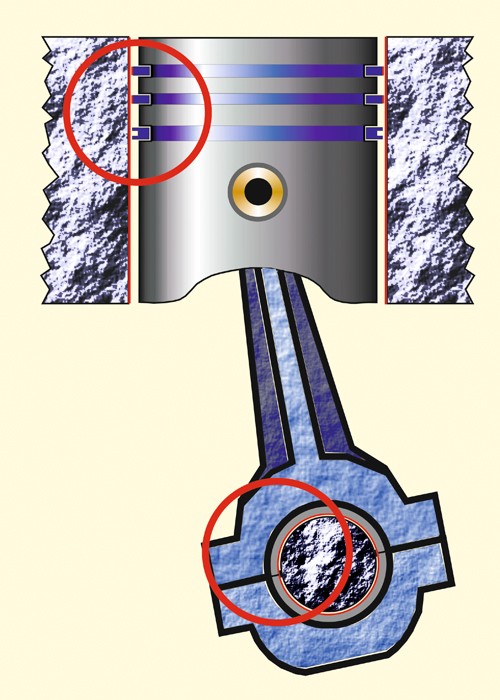
Causes and symptoms of car wheel bearing failure
The wheel bearing is responsible for the smooth and uniform rotation of the wheel without braking and deviations in the vertical plane. During movement, this part experiences very high loads, therefore, to ensure maximum reliability, it is made of high-strength materials.
Usually problems with them begin somewhere after 100-120 thousand kilometers. Although for high-quality wheel bearings with careful driving, 150 thousand is far from the limit. On the other hand, it happens that newly installed parts begin to fall apart after a run of two to three thousand kilometers. And it's not always about the quality of the bearing itself.
A number of factors can influence the appearance of problems with a wheel bearing.
- The first is associated with long-term operation and natural wear and tear. At the same time, a sharp driving style, frequent congestion of the car and bad roads are the main enemies of wheel bearings.
- The second factor is the loss of tightness. If the protective anthers were damaged during installation or during operation, the grease gradually leaks out, and dirt and sand get inside. In this case, the wear process will go at an accelerated pace.
- The third factor is improper installation, when the bearing is pressed into the hub with a misalignment. A skewed part will have to be changed again, perhaps already after a set of thousands of kilometers.
Finally, overtightening during installation can hasten the failure of a wheel bearing. For proper operation, the bearing must have a certain axial clearance.
Over-tightening the nuts will result in increased internal friction and overheating. During installation, you need to use and ensure that the nuts are tightened with the required torque.
First, there is a hum in the area of \uXNUMXb\uXNUMXbthe wheels. Often it disappears or intensifies when turning. The tone of the sound may change depending on the speed. It is possible to pull the car to the side due to the constant wedging of one of the wheels.
In some speed ranges, the rumble may be absent at first, but will gradually become constant, and then it will be replaced by a characteristic crunch and vibration, which can give a noticeable return to the steering wheel and body of the car.
Such a symptom suggests that the wheel bearing is almost destroyed and it is simply dangerous to continue driving. We urgently need to go to the service station at low speed.
A broken bearing can jam at some point, and the wheel will jam along with it. In this case, a defect in the ball joint of the suspension arm and deformation of the axle shaft are possible. If this happens at high speed, the car may end up on the side of the road and even roll over. And in the event of a departure into the oncoming lane during busy traffic, a serious accident is guaranteed.
Unlike many other automotive problems, identifying a bad wheel bearing is relatively easy.
You can find out which side the problematic part is on in turns while driving. When turning right, the load is redistributed to the left side, and the right wheel bearing is unloaded. If at the same time the hum disappears or noticeably decreases, then the problem is on the right. If the sound is amplified, then the left hub bearing must be replaced. When turning left, respectively, the opposite is true.
It happens that a similar noise comes from unevenly worn tires. To more accurately diagnose the problem, you need to place the car on a level surface and use the help to hang up the problem wheel (or two wheels at once). To eliminate possible noise from the CV joint, it is better to place the jack not under the body, but under the suspension arm.
With both hands, try to move the wheel in a vertical and horizontal plane. There should not be any backlash! The presence of even a small play indicates that the bearing is broken and needs to be changed.
It happens that wheel play is caused by wear of other parts. To eliminate this option, ask an assistant to depress the brake pedal and shake the wheel. If the play has disappeared, then the hub bearing is definitely defective. Otherwise, the problem should be sought in the suspension or steering.
Next, spin the wheel by hand and listen to the sound. You certainly will not confuse the specific crackling noise of a defective part with a quiet rustle when a working wheel rotates.
You can also use a lift. Start the engine and accelerate the wheels to a speed of approximately 70 km/h. then turn off the gear, turn off the engine and get out of the car. You can easily determine where the noise is coming from.
It may seem that replacing the bearing in the wheel hub is not tricky. However, this is only at first glance. It will take at least two special, mechanical experience and knowledge of the suspension device.
It should also be borne in mind that in some cases the bearing is not removable at all, then it will have to be bought and changed as an assembly with the hub.
Pressing requires a special clip. Under no circumstances should pointed tools be used. When fitting the bearing into the hub, the force should be transferred to the outer ring, and when installed on the axle - to the inner one.
Do not forget also about the correct axial clearance and the need for tightening with a certain moment. A misaligned or over-tightened bearing will not last long.
All this speaks in favor of entrusting the work to experienced specialists, the choice of which should be approached responsibly.
